Atrial flutter - Study guides, Class notes & Summaries
Looking for the best study guides, study notes and summaries about Atrial flutter? On this page you'll find 3261 study documents about Atrial flutter.
Page 3 out of 3.261 results
Sort by
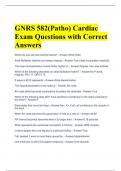
-
GNRS 582(Patho) Cardiac Exam Questions with Correct Answers
- Exam (elaborations) • 6 pages • 2024
-
Available in package deal
-
- $9.49
- 1x sold
- + learn more
GNRS 582(Patho) Cardiac Exam Questions with Correct Answers Where do you see saw-toothed waves? - Answer-Atrial flutter Atrial fibrillation rhythms are always irregular - Answer-True (read the question carefully) The major characteristics of atrial flutter rhythm is: - Answer-Regular, fast, saw-toothed Which of the following describes an atrial fibrillation rhythm? - Answer-No P wave, irregular, HR 111, QRS 0.12 P wave in ECG represents - Answer-Atrial depolarization The natural pacem...
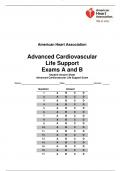 Popular
Popular
-
Advanced Cardiovascular Life Support (ACLS) Exams A and B 2023 A+
- Exam (elaborations) • 65 pages • 2024 Popular
-
- $17.98
- 11x sold
- + learn more
Advanced Cardiovascular Life Support (ACLS) Exams A and B 2023 A+ l Please do not mark on this exam. Record the best answer on the separate answer sheet. 1. Which type of atrioventricular block best describes this rhythm? A. First-degree B. Second-degree type I C. Second-degree type II D. Third-degree 2. Your patient is in cardiac arrest and has been intubated. To assess CPR quality, which should you do? A. Monitor the patient’s PETCO2 B. Obtain a 12-lead ECG C. Chec...
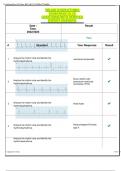
-
Complete 25 QUESTIONS with Solutions RELIAS Dysrhythmia Exam Identification-Basic B,2023
- Exam (elaborations) • 5 pages • 2023
-
- $6.99
- 2x sold
- + learn more
1 Analyze the rhythm strip and identify the rhythm/dysrhythmia. Junctional tachycardia 2 Analyze the rhythm strip and identify the rhythm/dysrhythmia. Sinus rhythm with premature ventricular contraction (PVC) 3 Analyze the rhythm strip and identify the rhythm/dysrhythmia. Atrial flutter 4 Analyze the rhythm strip and identify the rhythm/dysrhythmia. Second-degree AV block type II ...
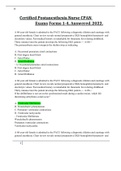
-
Certified Postanesthesia Nurse CPAN Exams Forms 1-4, Answered_2022.
- Exam (elaborations) • 81 pages • 2023
-
- $13.49
- 1x sold
- + learn more
Certified Postanesthesia Nurse CPAN Exams Forms 1-4, Answered_2022. A 60-year-old female is admitted to the PACU following a diagnostic dilation and curettage with general anesthesia. Chart review reveals normal preoperative EKG-hemoglobin-hematocrit- and electrolyte values. Past medical history is remarkable for rheumatic fever during childhood. Thirty minutes later the patient develops the following EKG pattern --- A-fib--- The perianesthesia nurse interprets the rhythm strip as indicati...
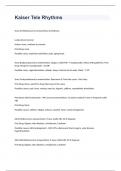
-
Kaiser Tele Rhythms-questions and answers
- Exam (elaborations) • 4 pages • 2023
-
- $11.99
- 2x sold
- + learn more
Sinus Arrhythmia Sinus Arrhythmia Looks almost normal Action: none, continue to monitor First Drug: none Possible cause: respiratory deviation, peds, aging heart Sinus Bradycardia Action: oxygen, notify MD - if symptomatic, follow AHA guidelines. First Drug: Atropine if symptomatic - low BP Possible cause: vagal-stimulation, athlete, sleep, ischemia to SA node, Meds, ↑ ICP Sinus Tachycardia Action: Determine & Treat the cause - this is key First Drug: None, watch for d...
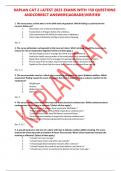
-
KAPLAN CAT 2 LATEST 2023 EXAMS WITH 150 QUESTIONS AND CORRECT ANSWERS|AGRADE(VERIFIED
- Exam (elaborations) • 52 pages • 2023
-
- $15.49
- 3x sold
- + learn more
KAPLAN CAT 2 LATEST 2023 EXAMS WITH 150 QUESTIONS AND CORRECT ANSWERS|AGRADE(VERIFIED 1. The nurse assess a client who is in the 24th week of gestation. Which finding is a priority for the nurse to follow-up? 1. Fetal heart rate of 130 to 140 beats/min. 2. Fundal level at 3 fingers below the umbilicus. 3. Fetal movements felt faintly on lower part of abdomen. 4. Client reports backache and leg cramps when sleeping. Ans: 2 2. The nurse administers carisoprodol to the incor...
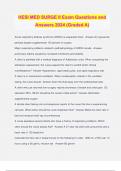
-
HESI MED SURGE II Exam Questions and Answers 2024 (Graded A)
- Exam (elaborations) • 15 pages • 2024
-
- $12.49
- 1x sold
- + learn more
HESI MED SURGE II Exam Questions and Answers 2024 (Graded A) Acute respiratory distress syndrome (ARDS) is suspected when: -Answer-A) hypoxemia persists despite supplemental 100 percent of oxygen. Major respiratory problems related to pathophysiology of ARDS include: -Answer- pulmonary edema caused by increased membrane permeability. A client is admitted with a medical diagnosis of Addisonian crisis. When completing the admission assessment, the nurse expects this client to exhibit which ...
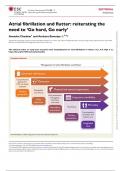
-
Atrial fibrillation and flutter: reiterating the need to ‘Go hard, Go early’ Aneesha Chauhan1 and Amitava Banerjee 2,3 *
- Exam (elaborations) • 3 pages • 2024
-
- $7.99
- + learn more
Atrial fibrillation and flutter: reiterating the need to ‘Go hard, Go early’ Aneesha Chauhan1 and Amitava Banerjee 2,3 *
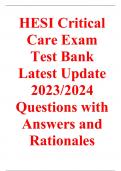
-
HESI Critical Care Exam Test Bank Latest Update 2023/2024 Questions with Answers and Rationales
- Exam (elaborations) • 76 pages • 2023
-
Available in package deal
-
- $20.49
- 1x sold
- + learn more
1. A client with asthma receives a prescription for high blood pressure during a clinic visit. Which prescription should the nurse anticipate the client to receive that is least likely to exacerbate asthma? A. Carteolol (Ocupress). B. Propranolol hydrochloride (Inderal). C. Pindolol (Visken). Incorrect D. Metoprolol tartrate (Lopressor). Correct The best antihypertensive agent for clients with asthma is metoprolol (Lopressor) (C), a beta2 blocking agent which is also cardiosel...
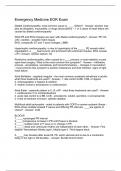
-
Emergency Medicine EOR Exam
- Exam (elaborations) • 31 pages • 2023
-
Available in package deal
-
- $12.99
- 1x sold
- + learn more
Dilated Cardiomyopathy: most common cause is ____. Others? - Answer- alcohol; may also be idiopathic, myocarditis, or drugs (doxorubicin) -- 1 in 3 cases of heart failure are caused by dilated cardiomyopathy What PE and EKG changes are seen with dilated cardiomyopathy? - Answer- PE: S3, JVD, crackles - possible mitral regurg EKG: nonspecific ST and T wave changes, LBBB Hypertrophic cardiomyopathy: is due to hypertrophy of the _____. PE reveals mitral regurgitation, a ____heart sound, and ...

How much did you already spend on Stuvia? Imagine there are plenty more of you out there paying for study notes, but this time YOU are the seller. Ka-ching! Discover all about earning on Stuvia


